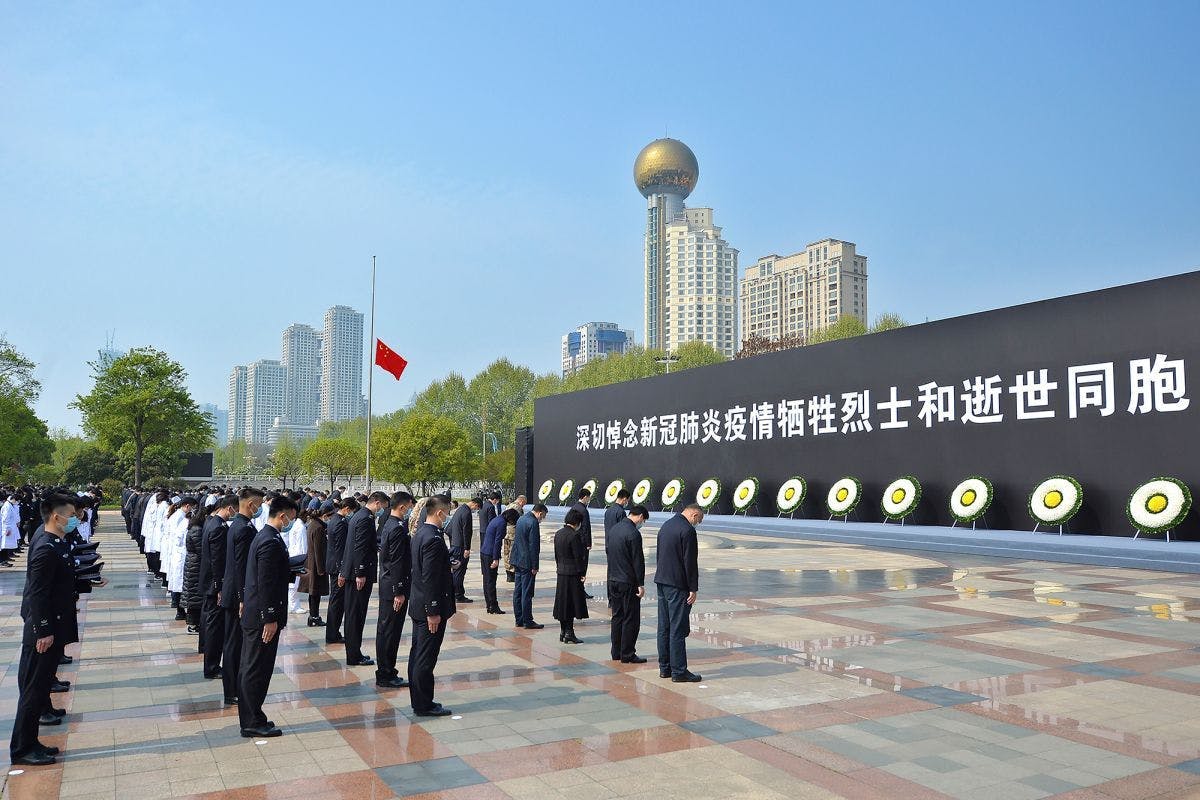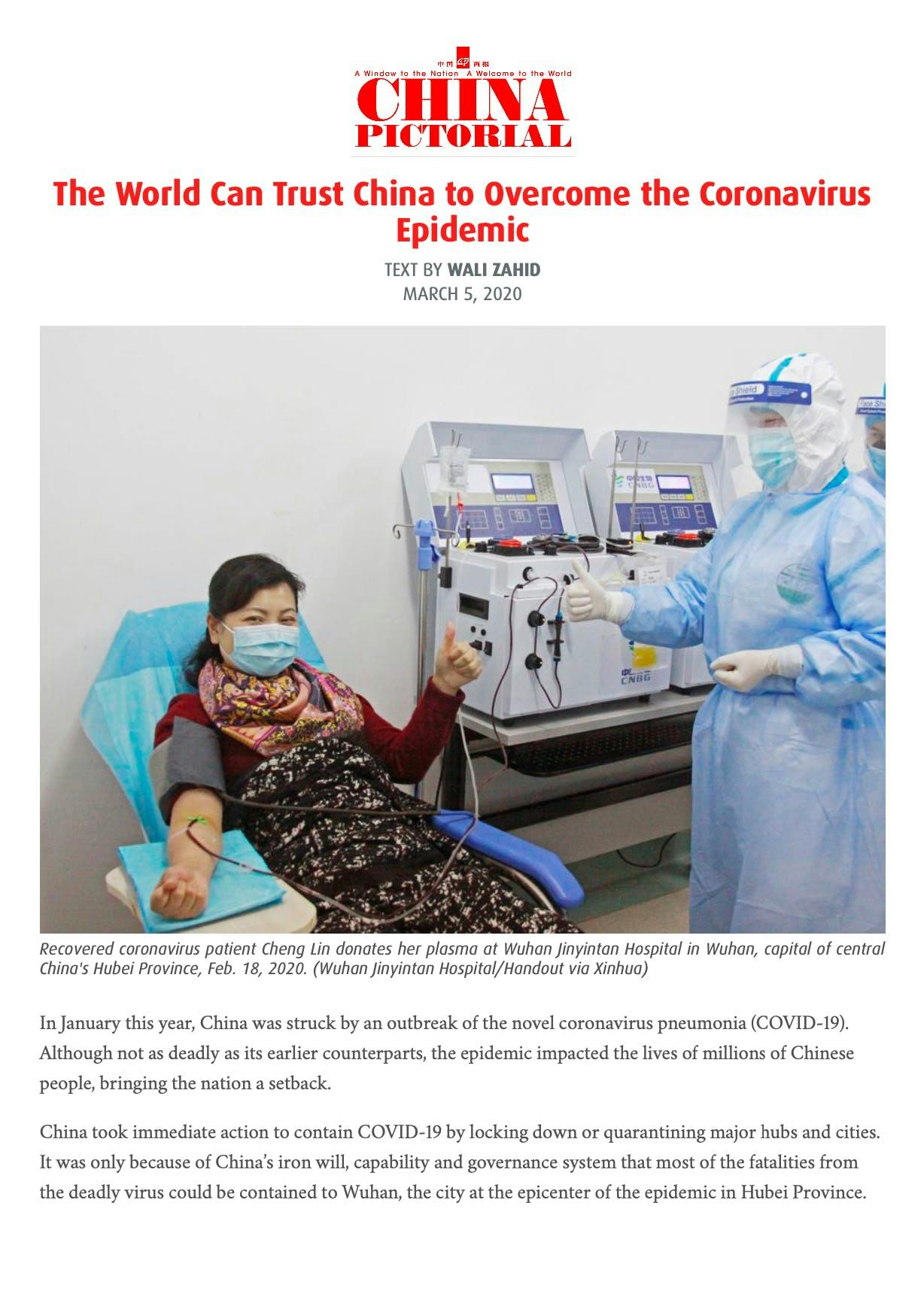How China contained coronavirus breakout

On Saturday, China held a national mourning for its doctors, paramedics and citizens who died in the fight against novel coronavirus outbreak and the patients who died of COVID-19 disease.
The mourning day serves as an appropriate occasion to document China’s response to global pandemic and what other affected countries could learn from it.
China’s response to novel coronavirus outbreak has been remarkable and unprecedented at several levels. Here are nine.
First, the decisive and clear-headed leadership developed through one-party CPC rule and incumbents’ graduation to positions of authority with years of experience in managing local and national affairs. The authorities in Wuhan city and Hubei province in central China, the epicenter of the outbreak, wasted no time in locking down cities when it was clear that the virus is deadly to humans. The one-party rule also saved time that democracies usually need in building bipartisan or multi-party consensus on potentially consequential decisions.
No panic buying reported
Second, the Chinese people did not react to quarantine and lockdown restrictions with resistance or panic. They stayed homes and when outside used masks to stop the coronavirus transmissions to potentially millions more and helping the authorities to flatten the curve. Also, there was no panic among general public in buying items of daily use like masks, paper towels or water like what we saw in recent weeks in the US or other affected countries.
Third, China being the ‘factory of the world’ was able to produce enough masks, sanitizers, PPEs, medical equipment and supplies to meet its demand in Wuhan, Hubei and other cities when the outbreak spread there. In fact, during a research in late January, I learnt that overseas Chinese bought masks from local markets and sent these back to China to meet local needs.
Fourth, using technology, China was able to monitor, track and quarantine the infected individuals and carriers of coronavirus. Nothing escaped the big brother. It was the same technology that South Korea and Singapore used to track and isolate patients from population at large, the latter with much faster response time.
Rapid and comprehensive response to rising cases
Fifth, true to the proverbial ‘China speed’, China was able to construct a 1,000-bed hospital in Wuhan in 10 days to admit coronavirus patients. Chinese doctors and paramedics fought the infectious disease with extra hours and dedication and some even gave their lives. The survivors will be long indebted to these brave individuals. Similarly, as opposed to other countries like the US and Europe, availability of enough diagnostic kits for testing the large number of population was not an issue in China.
Sixth, hoping that the data about confirmed cases and deaths provided by China’s CDC is correct and not under-reported as many in West believe, China was able to control the speed of new cases and resulting deaths. Since I started sharing the count of cases on social media platforms like Twitter and Facebook every day since Wuhan was locked down on 23 January, the percentage increase had been relatively small and in two digits. It was only between 10-24 February that the new reported deaths were in triple digits, 254 being the highest number on 13 February. Now, compare that with Italy’s highest single-day deaths of 971 on 28 March, 1,059 in United States on 2 April, 950 in Spain on 3 April, 743 in UK on 2 April, and 509 in France on 2 April.
Seventh, true to a YouGov survey of optimist populations in the world and China ranking at top, by 3 February, China’s CDC started updating the figures for recovered patients. The daily recovery count shifted the global outlook from confirmed cases and deaths to a new hope and optimism.
Eighth, where cities and populations were not as severely affected by coronavirus, China remained business as usual where it could: Inbound and outbound flights remained operational and factories remained open. Supply of essential items, food, groceries was not affected. The municipal services and disinfecting the cities remained functional.
Dealing with fake news
Ninth, fighting fake news, propaganda and Western accusations. On January 24, US President Trump tweeted praise for President Xi Jinping in containing coronavirus outbreak, because by that time the virus impact was in early stage and limited to the China Mainland. When in March coronavirus hit other countries and the US in particular, Trump went critical of China and started calling it the China virus, a racist term. Many other analysts called it Wuhan virus. China, in concert with WHO, faced this fake news phenomena with balance and resilience. There are still articles being published on mysteries about the origin of virus, the whistleblowing doctor, suppression of information and slow initial Chinese response and the veracity of CDC numbers. Accusations and counter-accusations are in play on Twitter and the world media outlets and both countries have expelled each other’s journalists.
Signs of China returning to normal
By mid-March it was clear that the pandemic curve had flattened in China as no new domestic cases were reported on 18-20 March, and Chinese businesses could restore their work routine. While these were now being shut down in rest of the world including the US, on 13 March, all 42 Apple Stores were reopened in China. In the second fortnight of March and first fortnight in April, China was the only place on earth where Apple Stores were open.
On 25 March, China lifted lockdown in Hubei with the exception of Wuhan and opened transport services. From 8 April, outbound traffic from Wuhan will be available.
US and Europe become new epicenters
By end-February, it appeared that new coronavirus epicenters had started to emerge – first Iran and South Korea, and then European countries – Italy in particular – followed by Spain, Netherlands, Germany, and UK. The United States followed.
By 19 March, Italy had crossed China in confirmed deaths at 3,200. Now, deaths in Italy are five times that of China.
By 26 March, the US had crossed China in confirmed number of cases, then at 82,000. Now, the US has nearly 300,000 confirmed cases, according to Johns Hopkins University.
It was now China’s turn to make its lessons learnt available to the rest of the world. China offered information sharing, case handling expertise, medical supplies and even Chinese doctors and paramedics to the new coronavirus epicenters of the world. It is now sending ventilators, masks and medics to Italy, France, Iran, the UK, and Pakistan.
US decision to work with China
China is now in a positioned to act as the world’s largest benefactor both in terms of how it contained coronavirus outbreak which it can pass on to rest of the world, but also supplying testing kits, ventilators and medical supplies and even doctors. President Xi has extended hand to all world leaders including the US President Trump. But it was not until 27 March when the US coronavirus cases surpassed China’s that President Trump tweeted about working closely with China. Hope this bodes well for both world superpowers and the humanity at large.
With the dysfunctional leadership of American President Donald Trump and UK’s Prime Minister Boris Johnson in dealing with the coronavirus pandemic, Chinese President Xi Jinping is emerging as a capable leader who can help the world fight the epidemic. I am reminded of what was said by Serbian President Aleksandar Vucic to reporters on 16 March: ‘The only country that can help us is China. For the rest of them [EU leaders], thanks for nothing.’
An earlier version of this article appeared in China Daily, Beijing on 3 April 2020. An updated version also appeared in The Nation, Islamabad, Pakistan, on 5 April.
Wali Zahid is a longtime China watcher and a Pakistan futurist. An award-winning journalist and formerly Editor of The News, Lahore, Pakistan’s largest-selling daily, he writes on issues of significance to Pakistan, CPEC & BRI and occasionally contributes to China Daily, People’s Daily China, China Pictorial, and Global Times.
As President of Institute of Media and Communications (IMC), Wali was a high-level delegate at Belt & Road Forum in Beijing in May 2017 and has spoken at Think Tanks Forum in Beijing.

Wali Zahid
Wali Zahid is a longtime China watcher and a Pakistan futurist. An award-winning journalist, he writes on issues of significance to Pakistan and CPEC & BRI.
Related posts
